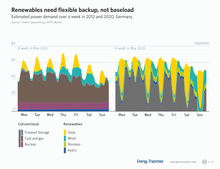Dispatchable generation

Dispatchable generation refers to sources of electricity that can be dispatched on demand at the request of power grid operators, according to market needs. Dispatchable generators can adjust their power output according to an order.[1] Non-dispatchable renewable energy sources such as wind power and solar photovoltaic (PV) power cannot be controlled by operators.[2] Other types of renewable energy that are dispatchable without separate energy storage are hydroelectric, biomass, geothermal and ocean thermal energy conversion.[3]
Startup time[]
Dispatchable plants have varying startup times.
The fastest plants to dispatch are grid batteries which can dispatch in milliseconds. Hydroelectric power plants can often dispatch in tens of seconds to minutes and natural gas power plants can generally dispatch in tens of minutes.
For example, the 1,728 MW Dinorwig pumped storage power plant can reach full output in 16 seconds.[4] Although theoretically dispatchable, coal and nuclear thermal plants are designed to run as base load power plants and may take hours or sometimes days to cycle off and then back on again.[5]
Utility-scale energy storage can compensate for intermittent wind power and solar PV power. During 2017, solar thermal storage power has become cheaper and a bulk dispatchable source.[6][7][8][9] Earlier, affordable large-scale storage technologies other than hydro were not available.
Benefits[]
The primary benefits of dispatchable power plants include:[10]
- providing spinning reserve (frequency control)
- balancing the electric power system (load following)
- optimizing economic generation dispatch (merit order)
- contributing to clearing grid congestion (redispatch)[clarification needed]
These capabilities of dispatchable generators allow:
- Load matching - slow changes in power demand between, for example, night and day, require changes in supply too, as the system needs to be balanced at all times (see also Electricity).
- Peak matching - short periods of time during which demand exceeds the output of load matching plants; generation capable of satisfying these peaks in demand is implemented through quick deployment of dispatchable sources.
- Lead-in times - periods during which an alternative source is employed to supplement the lead time required by large coal or natural gas fueled plants to reach full output; these alternative power sources can be deployed in a matter of seconds or minutes to adapt to rapid shocks in demand or supply that cannot be satisfied by peak matching generators.
- Frequency regulation or intermittent power sources - changes in the electricity output sent into the system may change quality and stability of the transmission system itself because of a change in the frequency of electricity transmitted; renewable sources such as wind and solar are intermittent and need flexible power sources to smooth out their changes in energy production.
- Backup for base-load generators - Nuclear power plants, for example, are equipped with nuclear reactor safety systems that can stop the generation of electricity in less than a second in case of emergency.
Alternative classification[]
A 2018 study suggested a new classification of energy generation sources, which accounts for fast increase in penetration of variable renewable energy sources, which result in high energy prices during periods of low availability:[11]
- "Fuel saving" variable renewable energy, which have near zero variable costs and zero fuel costs by using power of wind, Sun and run-of-river hydropower. With large share of these sources, "capacity needs are driven by periods with low VRE availability" and therefore their proposed role is to replace other high-variable cost sources at periods when they are available.
- "Fast-burst" are energy sources that can be instantly dispatched during periods of high demand and high energy prices, but are poorly performing for long term continuous operations. These include energy storage (batteries), flexible demand and demand response.
- "Firm" low-carbon sources, which provide stable energy supply during all seasons and during periods up to weeks or months, and include nuclear power, hydro plants with large reservoirs, fossil fuels with carbon capture, geothermal and biofuels.
See also[]
- Peaking power plant
- Load following power plant
- Intermittent energy source
References[]
- ^ Cooper, Duncan (22 March 2012). "Johnson's Energy Club Competes in Renewable Energy Case Competition". Samuel Curtis Johnson Graduate School of Management. Archived from the original on 16 June 2012. Retrieved 29 August 2012.
Most conventional energy sources are dispatchable, meaning that they can be turned on or off according to the demand for electricity. The amount of electricity they produce can also be turned up or down so that supply of electricity matches the amount demanded by users.
- ^ Electricity Grid: Key Terms and Definitions
- ^ Global Energy Assessment: Toward a Sustainable Future
- ^ "Welcome to First Hydro" (PDF). Archived from the original (PDF) on 2016-03-03. Retrieved 2013-01-08.
- ^ Archived 30 November 2019 at the Wayback Machine "three to four days"
- ^ "Dispatchable Concentrated Solar Power Broke Price Records in 2017". Retrieved 22 September 2017.
- ^ "UAE's push on concentrated solar power should open eyes across world". Retrieved 26 September 2017.
- ^ "Commercializing Standalone Thermal Energy Storage". 8 January 2016. Retrieved 1 September 2017.
- ^ Lewis, Dyani (5 April 2017). "Salt, silicon or graphite: energy storage goes beyond lithium ion batteries". The Guardian. Retrieved 1 September 2017.
- ^ How can renewables deliver dispatchable power on demand?
- ^ Sepulveda, Nestor A.; Jenkins, Jesse D.; De Sisternes, Fernando J.; Lester, Richard K. (2018-11-21). "The Role of Firm Low-Carbon Electricity Resources in Deep Decarbonization of Power Generation". Joule. 2 (11): 2403–2420. doi:10.1016/j.joule.2018.08.006. ISSN 2542-4351.
- Electric power